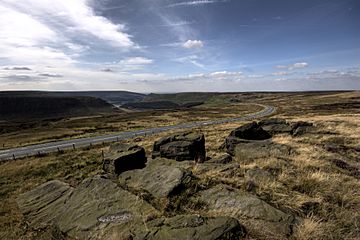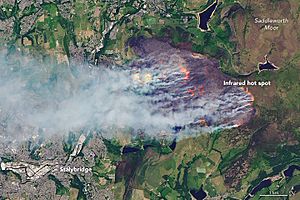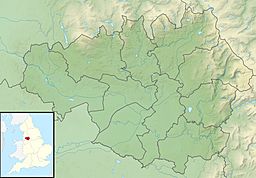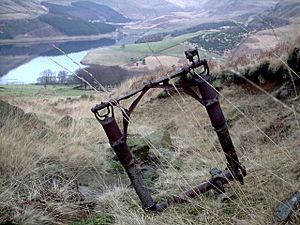Saddleworth Moor facts for kids
Quick facts for kids Saddleworth Moor |
|
|---|---|

Saddleworth Moor towards Dovestone Reservoir
|
|
| Highest point | |
| Geography | |
| Location | Northern England |
| Parent range | Peak District |
| Geology | |
| Mountain type | Moorland |
| Climbing | |
| Easiest route | Pennine Way |
Saddleworth Moor is a large area of moorland in North West England. It rises more than 400 meters (1,312 feet) above sea level. This moor is part of the Dark Peak area within the Peak District National Park. A main road, the A635 road, crosses it, and the famous Pennine Way walking path runs along its eastern side.
Contents
What is Saddleworth Moor Like?
This moor gets its name from the nearby area of Saddleworth to its west. Even though it's on the western side of the Pennines hills, it has been part of Greater Manchester since 1974. The moor is a high, flat area with rocky cliffs called escarpments. Around its edges, you'll find deep, V-shaped valleys known as cloughs, where fast-flowing streams run.
Saddleworth Moor stretches across two different areas: Oldham in Greater Manchester and Kirklees in West Yorkshire. The moorland east of the border with West Yorkshire is called Wessenden Moor. The A635 road, sometimes called the Isle of Skye road, crosses the moor. This road connects the big cities of Greater Manchester and West Yorkshire.
The Pennine Way walking path comes from the Wessenden Valley in the north. It crosses the moor as it climbs towards Black Hill to the south. This high moorland doesn't have many people living on it. You can see scattered farmhouses made of stone and fields separated by dry stone walls in the lower areas and valleys. There are also some forests with cone-bearing trees. The ground is covered in peat, which has drainage channels called groughs cut into it. Much of this area is open for people to explore.
Plants and Nature on the Moor
The area has a special type of wet ground called Blanket bog. This is the most south-easterly place in Europe where you can find it. You'll see a lot of cottongrass here. However, there isn't much sphagnum moss. Other plants like heather, crowberry, bilberry, and the rare cloudberry also grow here. The peat on the moor is about 9,000 years old! But in many places, the top layer of peat has worn away, leaving bare ground.
Water Reservoirs of Saddleworth Moor
East of Oldham, you'll find several reservoirs: Dovestone, Yeoman Hey, Greenfield, and Chew Reservoir. You can reach them from the A635 road. These reservoirs are very important because they supply water to the nearby towns and cities. The valleys around them are surrounded by rocky hills and moorland. You'll see Spruce and pine trees planted in the valley. Other types of trees have also been added to create a more varied home for wildlife.
Yeoman Hey Reservoir was built in 1880. Chew Reservoir was built in 1914 and was once the highest reservoir in the British Isles, sitting 488 meters (1,601 feet) above sea level. You can still see the path of a tramway that was built to help construct it. The area around the reservoirs is a popular spot for outdoor activities.
Important Events at Saddleworth Moor
In August 1949, a passenger plane, a BEA Douglas DC3, crashed into the hill at Wimberry Stones. This happened at the top of the Chew Valley. Sadly, 24 people on board passed away, but eight people survived the crash.

A large wildfire started on the moor on June 24, 2018. This fire caused many people to leave their homes and damaged a huge area. About 50 homes were evacuated, and around 150 people in Carrbrook, near Stalybridge, were affected. Firefighters worked hard for many days to put out the blaze.
Because Saddleworth Moor is a peat moor, the fire often burned underground before spreading to other parts of the moor. This made it very difficult to fight. It also created a lot of smoke and reached extremely high temperatures. Fire chiefs thought the fire could continue for several weeks after it first started.
In February 2019, on the warmest winter day ever recorded, another fire broke out on the moor. People who saw it described it as "apocalyptic," meaning it looked like the end of the world.
|
See also
 In Spanish: Pradera de Saddleworth para niños
In Spanish: Pradera de Saddleworth para niños



